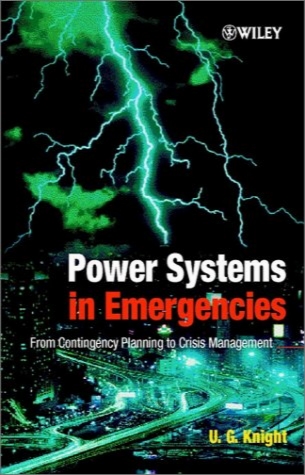Power systems in emergencies : from contingency planning to crisis management
- نوع فایل : کتاب
- زبان : انگلیسی
- مؤلف : Upton George Knight
- ناشر : Chichester [u.a.] : John Wiley,
- چاپ و سال / کشور: 2001
- شابک / ISBN : 9780471490166
Description
1 Introduction and Contents 1.1 Review of Contents 1.2 General Approach of the Book 2 Disturbances in Power Systems and their Effects 2.1 Sudden Disturbance 2.1.1 Weather 2.1.2 Environment 2.1.3 2.1.4 Plant Failure 2.1.5 Human Error Balance between Demand and Generation 2.2 Predictable Disturbances 2.2.1 Shortage of Plant Capacity 2.2.2 Shortage of Fuel 2.2.3 Shortage of ‘Ancillary’ Supplies 2.2.4 Shortage of Operating Staff 2.2.5 Shortage of Control Staff 2.3.1 Thermal Overloads 2.3.2 2.3.3 Voltage Outside Limits 2.3.4 Frequency Outside Limits 2.3.5 2.3.6 Voltage Instability 2.3 Forms of System Failure Switchgear Ratings, Excessive System Fault Levels Steady State, Transient and Dynamic Stability 2.4 Analysis Techniques 2.4.1 2.4.2 Fault Levels 2.4.3 Transient Stability 2.4.4 Dynamic Stability 2.4.5 Medium and Long-term Stability Steady State Flows and Voltages 7 7 7 8 9 9 10 10 11 11 12 12 12 13 14 14 15 19 20 21 26 26 28 28 32 33 V vi CONTENTS 2.5 Trends in the Development of Analytical Techniques 33 References Further Reading 34 34 3 Some General Aspects of Emergency Control 35 3.1 Definitions and Concepts used in Emergency Control 3.1.1 Definitions 3.1.2 System States 3.1.3 Objectives 3.1.4 System States, Contingencies and Types of Control 35 35 36 37 37 3.2 Some Standard Terminology 39 3.3 The Effects of Various Types of Fault or Disturbance on System Performance 40 3.3.1 Sudden Deficit of Generation or Equivalent 3.3.2 Sudden Deficit of Demand or Equivalent 3.3.3 Sudden Loss of Transmission (Not Resulting in an Immediate System Split) 3.3.4 Sudden Loss of Transmission (Resulting in a System Split) 3.4 Typical Pattern of the Development of a Sudden Disturbance 3.5 Conceptual Forms of Emergency Control 3.6 Effect of System Structure on the Need for and Implementation of Emergency Control 3.6.1 3.7 Design Criteria for Emergency Control Facilities References Effect of System Structure on the Form of Emergency Control 4 The Power System and its Operational and Control Infrastructure 4.1 Structure 4.1.1 A Theory on the Evolution of Network Voltages 4.2 The Functions of Interconnection 4.2.1 Exchanges Between Neighbours 4.3 The Alternatives for Main Transmission 4.3.1 4.4 Security and Quality of Supply in Planning and Operation 4.4.1 Standards of Security in Planning 4.4.2 Standards of Security in Operation 4.4.3 Standards of Quality 4.5 Timescales in System Operation and Control 4.5.1 Operational Planning 4.5.2 Extended Real-Time Analysis 4.5.3 Real-Time Operation The Roles of Direct Current Interconnection and Transmission 40 42 44 44 44 46 50 51 51 52 53 53 57 57 58 59 62 63 64 67 72 77 78 83 84 CONTENTS vii 89 90 92 93 4.5.4 Facilities 4.5.5 Post-Event Tasks 4.5.6 Operator Training 4.5.7 Models Used in Post-Event Tasks 4.6 SCADA 4.6.1 Questions on Functions and Structure 4.6.2 Questions on Performance Criteria 4.6.3 Information Required at Control Centres 4.6.4 Information Sent Out from Control Centres 4.6.5 The Human-Computer Interface 4.6.6 Availability Requirements for SCADA Systems and their Structure 4.7 Energy Management Systems 4.8 Communications and Telemetry 4.9 Telecommand 4.10 Distributed Generation 4.1 1 Flexible a.c. Transmission Systems (FACTS) 4.1 1.1 4.11.2 Some FACTS Devices Factors Preventing Full Thermal Loading of Circuits in an a.c. Network


